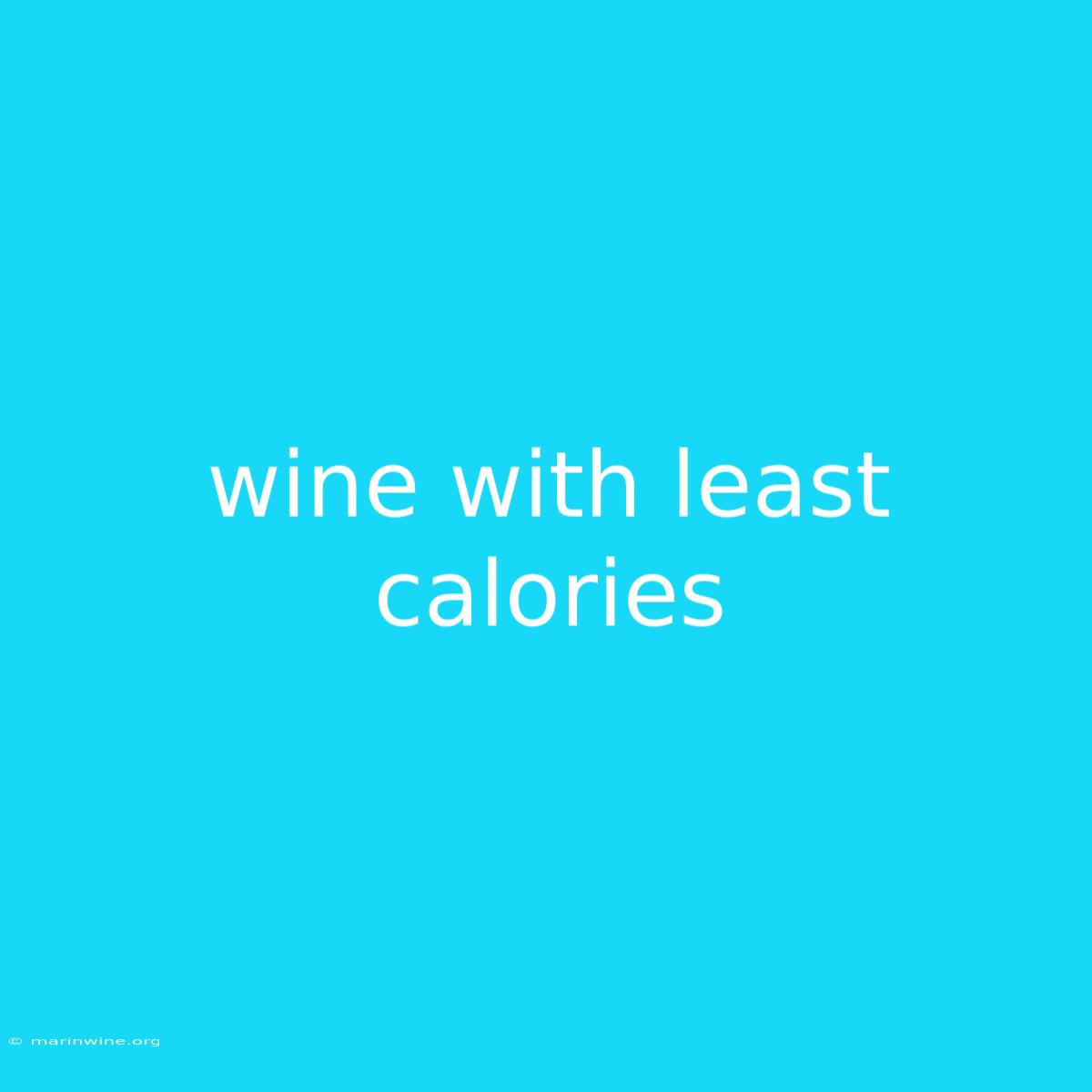Uncorking the Secrets: Wines with the Lowest Calorie Counts
Have you ever wished you could enjoy a glass of wine without the guilt? It's true, wine can pack a caloric punch, but not all wines are created equal. There are ways to savor the rich flavors of wine while staying mindful of your calorie intake.
Why It Matters:
Understanding the calorie content of wine is important for those watching their weight, managing their health, or simply seeking a more mindful approach to enjoying their favorite beverage. This article explores the factors influencing wine's calorie content and unveils the lowest-calorie options available, empowering you to make informed choices.
Key Takeaways of Wine Calories:
| Factor | Impact on Calories |
|---|---|
| Type of Wine | Dry wines generally lower in calories |
| Sugar Content | Sweet wines higher in calories |
| Alcohol Content | Higher alcohol = higher calories |
| Serving Size | Larger servings = more calories |
Let's dive into the world of low-calorie wines:
Dry Wines: Your Low-Calorie Allies
Dry wines are often the go-to choice for calorie-conscious drinkers. These wines, characterized by their absence of residual sugar, generally boast a lower calorie count.
Key Aspects of Dry Wines:
- Sugar Content: Dry wines have little to no residual sugar, meaning they have fewer calories from sugar.
- Alcohol Content: While alcohol does contribute calories, dry wines typically have moderate alcohol levels, further reducing the overall calorie count.
- Flavors: Dry wines offer a wide range of flavors, from crisp and refreshing to complex and earthy.
Examples of Dry Wines:
- Sauvignon Blanc: Known for its zesty acidity and notes of grapefruit and green apple.
- Pinot Grigio: Renowned for its lightness and refreshing flavors of pear and citrus.
- Dry Riesling: Offers a crisp acidity balanced with delicate floral and fruity notes.
- Pinot Noir: Characterized by its elegant aromas of red fruit and earthy tones.
- Gamay: Known for its light body, fruity flavors, and refreshing acidity.
Light-Bodied Wines: A Calorie-Conscious Choice
Light-bodied wines are typically lower in alcohol content and tannins, resulting in fewer calories. They offer a delicate and refreshing experience, making them ideal for lighter meals or sipping on a warm day.
Key Aspects of Light-Bodied Wines:
- Alcohol Content: These wines have lower alcohol levels, translating to fewer calories.
- Tannins: Light-bodied wines contain less tannins, which are naturally occurring compounds that contribute to bitterness and can increase the perceived heaviness of the wine.
- Aromas: Light-bodied wines often display delicate aromas of fruit, flowers, and herbs.
Examples of Light-Bodied Wines:
- Grüner Veltliner: A crisp and refreshing Austrian white wine with notes of citrus, green apple, and white pepper.
- Albariño: A Spanish white known for its bright acidity and aromas of grapefruit and lime.
- Dolcetto: An Italian red wine with notes of cherry, plum, and a touch of spice.
Sparkling Wines: A Fizz with Less Calories
Don't think you have to forgo the celebratory bubbles! Sparkling wines, especially dry styles like Brut, offer a refreshing and festive option with a lower calorie count compared to sweeter styles.
Key Aspects of Sparkling Wines:
- Sugar Content: Dry sparkling wines, like Brut, have minimal sugar content, minimizing the calorie contribution from sugar.
- Carbonation: The bubbles in sparkling wines can actually make them feel more satisfying, potentially leading to a lower overall consumption.
- Versatile Pairing: Sparkling wines can complement a wide range of dishes, making them a delightful addition to any occasion.
Examples of Low-Calorie Sparkling Wines:
- Brut Champagne: Renowned for its elegant bubbles, crisp acidity, and notes of citrus and brioche.
- Prosecco: An Italian sparkling wine known for its vibrant fruitiness and floral aromas.
- Cava: A Spanish sparkling wine that offers a wide range of styles, from dry to sweet.
FAQ for Low-Calorie Wine
Q: What are the biggest myths about wine calories?
A: One common myth is that red wines are always higher in calories than white wines. This is not necessarily true, as the calorie content depends more on factors like sugar content and alcohol level.
Q: How can I reduce the calorie content of my wine?
A: Choosing dry wines, opting for smaller servings, and diluting with water or soda can all help reduce the calorie intake.
Q: Can I drink wine and still lose weight?
A: It's possible to enjoy a glass of wine while maintaining a healthy weight. Moderation is key, and incorporating low-calorie wines into a balanced diet and exercise plan can be beneficial.
Q: Are there other factors that influence the calorie content of wine?
**A: ** Yes, factors such as the grape variety, vineyard location, and winemaking techniques can all influence the calorie content.
Tips for Choosing Low-Calorie Wines:
- Check the label: Look for dry wines or those with lower alcohol content.
- Ask your sommelier: Wine professionals can provide valuable insights and recommend low-calorie options.
- Experiment: Try different wines to discover your favorites among the lower-calorie choices.
- Mix and match: Pair low-calorie wines with lighter meals or snacks.
- Drink responsibly: Moderate consumption is key to maintaining a healthy lifestyle.
Summary by Wine Calories:
This exploration has shed light on the factors influencing wine's calorie content and unveiled a range of low-calorie options to savor. From dry wines to light-bodied varieties and sparkling alternatives, you can enjoy the pleasures of wine while staying mindful of your calorie intake. Remember, moderation is key to enjoying a healthy and balanced lifestyle. Cheers to mindful drinking!

